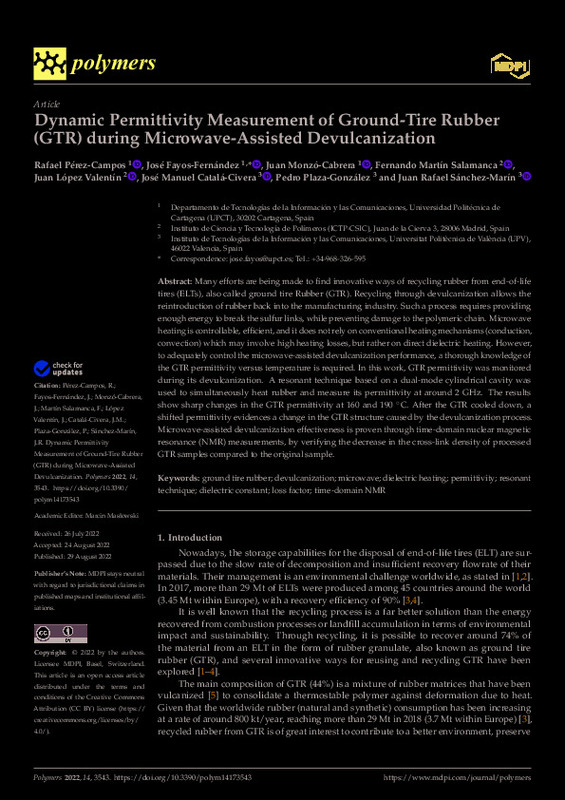Pérez-Campos, R.; Fayos-Fernández, J.; Monzó-Cabrera, J.; Martín Salamanca, F.; López Valentín, J.; Catalá Civera, JM.; Plaza González, PJ.... (2022). Dynamic Permittivity Measurement of Ground-Tire Rubber (GTR) during Microwave-Assisted Devulcanization. Polymers. 14(17):1-21. https://doi.org/10.3390/polym14173543
Por favor, use este identificador para citar o enlazar este ítem: http://hdl.handle.net/10251/194027
|
Título:
|
Dynamic Permittivity Measurement of Ground-Tire Rubber (GTR) during Microwave-Assisted Devulcanization
|
|
Autor:
|
Pérez-Campos, Rafael
Fayos-Fernández, José
Monzó-Cabrera, Juan
Martín Salamanca, Fernando
López Valentín, Juan

 Catalá Civera, José Manuel
Catalá Civera, José Manuel

 Plaza González, Pedro José
Plaza González, Pedro José

 Sánchez-Marín, Juan Rafael
Sánchez-Marín, Juan Rafael
|
|
Entidad UPV:
|
Universitat Politècnica de València. Escuela Técnica Superior de Ingenieros de Telecomunicación - Escola Tècnica Superior d'Enginyers de Telecomunicació
|
|
Fecha difusión:
|
|
|
Resumen:
|
[EN] Many efforts are being made to find innovative ways of recycling rubber from end-of-life tires (ELTs), also called ground tire Rubber (GTR). Recycling through devulcanization allows the reintroduction of rubber back ...[+]
[EN] Many efforts are being made to find innovative ways of recycling rubber from end-of-life tires (ELTs), also called ground tire Rubber (GTR). Recycling through devulcanization allows the reintroduction of rubber back into the manufacturing industry. Such a process requires providing enough energy to break the sulfur links, while preventing damage to the polymeric chain. Microwave heating is controllable, efficient, and it does not rely on conventional heating mechanisms (conduction, convection) which may involve high heating losses, but rather on direct dielectric heating. However, to adequately control the microwave-assisted devulcanization performance, a thorough knowledge of the GTR permittivity versus temperature is required. In this work, GTR permittivity was monitored during its devulcanization. A resonant technique based on a dual-mode cylindrical cavity was used to simultaneously heat rubber and measure its permittivity at around 2 GHz. The results show sharp changes in the GTR permittivity at 160 and 190 degrees C. After the GTR cooled down, a shifted permittivity evidences a change in the GTR structure caused by the devulcanization process. Microwave-assisted devulcanization effectiveness is proven through time-domain nuclear magnetic resonance (NMR) measurements, by verifying the decrease in the cross-link density of processed GTR samples compared to the original sample.
[-]
|
|
Palabras clave:
|
Ground tire rubber
,
Devulcanization
,
Microwave
,
Dielectric heating
,
Permittivity
,
Resonant
technique
,
Dielectric constant
,
Loss factor
,
Time-domain NMR
|
|
Derechos de uso:
|
Reconocimiento (by)
|
|
Fuente:
|
Polymers. (eissn:
2073-4360
)
|
|
DOI:
|
10.3390/polym14173543
|
|
Editorial:
|
MDPI AG
|
|
Versión del editor:
|
https://doi.org/10.3390/polym14173543
|
|
Código del Proyecto:
|
info:eu-repo/grantAgreement/AEI/Plan Estatal de Investigación Científica y Técnica y de Innovación 2017-2020/PID2020-119047RB-I00/ES/NUEVAS METODOLOGIAS PARA EL RECICLADO DE PLASTICOS Y CAUCHO PARA APLICACIONES DE ALTO VALOR AÑADIDO/
info:eu-repo/grantAgreement/CSIC//201860E045/
info:eu-repo/grantAgreement/EC/H2020/870000/EU
info:eu-repo/grantAgreement/Gobierno de Aragón//EC-22-2021/
info:eu-repo/grantAgreement/MICINN//PLEC2021-007793/
|
|
Agradecimientos:
|
This research project has received funding from the European Union's Horizon 2020 research and innovation program under grant agreement number 870,000. More information at https://cordis.europa.eu/project/id/870000 (accessed ...[+]
This research project has received funding from the European Union's Horizon 2020 research and innovation program under grant agreement number 870,000. More information at https://cordis.europa.eu/project/id/870000 (accessed on 27 August 2022) and https://valuerubber.eu/(accessed on 27 August 2022). JLV and FMS also thanks the funding from Ministerio de Ciencia e Innovacion (PID2020-119047RB-I00 y PLEC2021-007793), Gobierno de Aragon (EC-22-2021) and CSIC (201860E045).
[-]
|
|
Tipo:
|
Artículo
|









